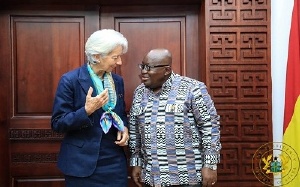 President Akufo-Addo in an interaction with IMF boss Christine Lagarde
President Akufo-Addo in an interaction with IMF boss Christine Lagarde
Ghana, currently the 11 biggest economy in Africa, is expected to become the fourth fastest-growing economy in Africa this year, according to the International Monetary Fund (IMF).
The West African country is expected to hit 7.6 per cent Gross Domestic Product (GDP) growth rate, from the projected 6.3 per cent GDP in 2018, the IMF said, adding “Ghana is an economic powerhouse in West Africa with a GDP size of approximately $51 billion.”
Oil-rich Libya is expected to become the fastest growing economy in Africa with a GDP growth rate of 10.8 per cent this year. The North African country currently has a GDP of over $50.95 billion.
Ethiopia and Rwanda, which was the first and second fastest-growing economies in Africa in 2018, are expected to grow at 8.5 per cent and 7.8 per cent respectively this year, making them the second and third fastest-growing economies for 2019.
The IMF in its recent global report projected a 7.6 per cent GDP growth rate for Ghana in 2019, 6.3 per cent in 2020 and 6.1 per cent in 2021 respectively.
Last week, the IMF Board set March 2019 for Ghana’s final programme preview before exit following a week assessment of the Ghanaian economy.
According to the IMF staff mission led by Annalisa Fedelino, the government has made “good progress implementing the Extended Credit Facility-supported program, which will end on April 3, 2019, as envisaged”.
It pointed out that six out of nine end-December 2018 quantitative targets under the programme were met and structural reforms are advancing.
The Ivory Coast also known as “Cote d’Ivoire” with a GDP size of about $41 billion is projected by the IMF to grow by 7 per cent in 2019, making the fifth fastest-growing economy.
It is followed by Senegal, Tanzania and Benin in 6th, 7th and 8th respectively. Whilst French-speaking Senegal with a GDP size of approximately US$17 billion is projected to grow by 6.7 per cent in 2019 by the IMF, Anglophone Tanzania a country located in East-Africa with a GDP size of about US$52.09 billion is estimated to grow by 6.6 per cent in 2019. Neighbouring Benin is projected to grow by 6.3 per cent in 2019, improvement from 6 per cent in 2018.
In 9th and 10th position are Uganda and Kenya. The two east African countries are projected to grow by 6.2 per cent and 6.1 per cent respectively this year. The GDP size of Uganda is over US$26 billion and Kenya is US$74.94 billion.
Ghana’s economy hit 7.4 per cent growth in the third quarter of 2018 compared to 8.7 per cent the same period 2017.
According to the figures, the non-oil provisional 2018 quarter three year-on-year real GDP growth rate was 8.5 per cent versus 4.9 per cent recorded during the same period last year.
The Bank of Ghana earlier said Ghana’s economic growth has been firm and is expected to remain steady over the medium-term as shown in its leading indicator of economic activity.
According to its Monetary Policy Report released in December 2018, “this is on top of the expected increase in activity in the real sector of the economy after the bank recapitalization exercise.”
It however said some risks however remain, relating essentially to uncertainty about the impact of global developments on domestic economic growth with higher fuel prices and exchange rate depreciation.